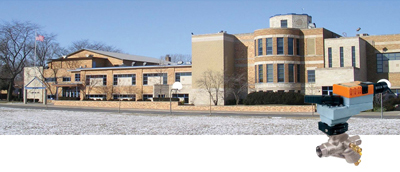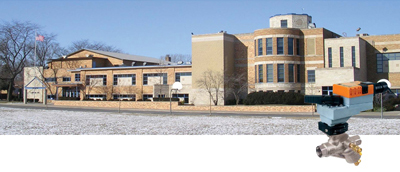Belimo Bridges the Gap Between Proprietary Control System and Control Valves at Middle School
 One teacher threatened to wear a bathing suit to class (in mid-winter) if the overheating problem at the Lincoln Hall Middle School in Lincolnwood, Illinois wasn't soon corrected. Clearly, it’s hard enough to make a 13-year old concentrate; and even though Jim Caldwell, Director of Buildings & Grounds was pretty sure this was an idle (and good-humored) threat, the school was ready to find a control solution for the unit ventilators that were overheating several classrooms.
One teacher threatened to wear a bathing suit to class (in mid-winter) if the overheating problem at the Lincoln Hall Middle School in Lincolnwood, Illinois wasn't soon corrected. Clearly, it’s hard enough to make a 13-year old concentrate; and even though Jim Caldwell, Director of Buildings & Grounds was pretty sure this was an idle (and good-humored) threat, the school was ready to find a control solution for the unit ventilators that were overheating several classrooms.
Ironically, all the equipment worked fine - it was the fact that the pressures were beyond what the existing end-of-cycle valves could handle that caused the overheating problem. The obvious solution - changing out the valves - was not an option because the face & bypass control system specified for the unit ventilators used a built-in electronic control system that required a specific brand of valve. Unfortunately, that particular valve was not rated for the uniquely high pressures at Lincoln Hall Middle School. It was a unique set of circumstances that required a lot of cooperation between the engineer, the school, and Belimo Americas, who ultimately provided the control valves and actuators for the project.
The school district site is very unique, consisting of three school buildings, Lincoln Hall, Rutledge Hall, and Todd Hall, all located on a 10 acre campus. The problem was not the unit ventilators per se, but a combination of factors, particularly at the Lincoln Hall Middle School where 1) the circulation pumps were large - having high gpm capacity at a rather high head pressure, 2) the piping system was of a direct return configuration , and 3) most of the unit ventilator end-of-cycle valves were of the 2-way variety. The pressures at the school were so high that the end-of-cycle valves could not close against the flow, so hot water continued to flow through the ventilators despite the fact that the actuators were getting the signal to close the valve. Other problems existed that made it difficult to automatically control the hot water reset control system. As a result, Jim Caldwell and other facility personnel were spending a large part of their day going from classroom to classroom and manually closing valves.
Making It Work
Robert Morgan, P. E., of Robert E. Morgan Associates, knew that Belimo’s line of characterized control valves combined the power and reliability of a globe valve with the simplicity and size of a ball valve. He also knew the valves could withstand the high pressures at Lincoln Hall. The challenge was to modify the Belimo actuator so that it could work with the existing control system.
The solution involved alterations to both the Belimo actuator and the control software. Belimo requested that the same model ventilator and control system be sent to its Danbury, CT office where Belimo’s electronic engineers were able to develop an interface printed circuit board (PCB) so that the valve actuator could communicate with the existing controller. Both CCV (Characterized Control Valve) and PICCV (Pressure Independent Characterized Control Valves) were used on the original 2-classroom project. The PICCV combines the features of an equal percentage control valve with a pressure regulator, which was particularly helpful in this application since large pressures were always a concern.
“The Belimo PICCV control valve not only properly controls the flow of hot or chilled water to the classroom unit ventilator, it also prevents excess flow from going through the unit,” remarked Robert Morgan.
A Likely Solution Elsewhere
Plans are currently underway to retrofit the remaining unit ventilators at Lincoln Hall with the Belimo control valves, and the newly adapted actuator. Morgan indicated that the installation of the new Belimo control valves, along with new variable speed pump drives, will provide excellent temperature control, allow the hydronic chilled-hot water system to be self balancing, substantially increase operating efficiency, and will lesson the “water noise” problems that sometimes occurred throughout the system. Although the two adjacent schools, Todd Hall and Rutledge Hall, do not have the same pressure issues or the same direct return control system, Morgan would like to employ the same characterized control valve technology and variable speed pump drives to both schools so that they too can improve temperature control and operating efficiency.
While the situation at Lincoln Hall was unique, Morgan suspects that schools and other facilities with high pressure issues and same type of ventilators may face the same problem. Where that is the case, Morgan surmises that Belimo control valves may be the only cost-effective solution. As for the classrooms with retrofitted unit ventilators at Lincoln Hall, conditions are much improved. And neither teachers nor students need shed any more than a coat or a sweater to be comfortable.

